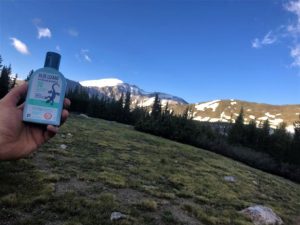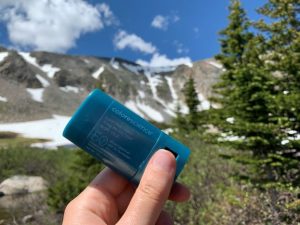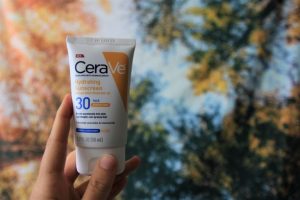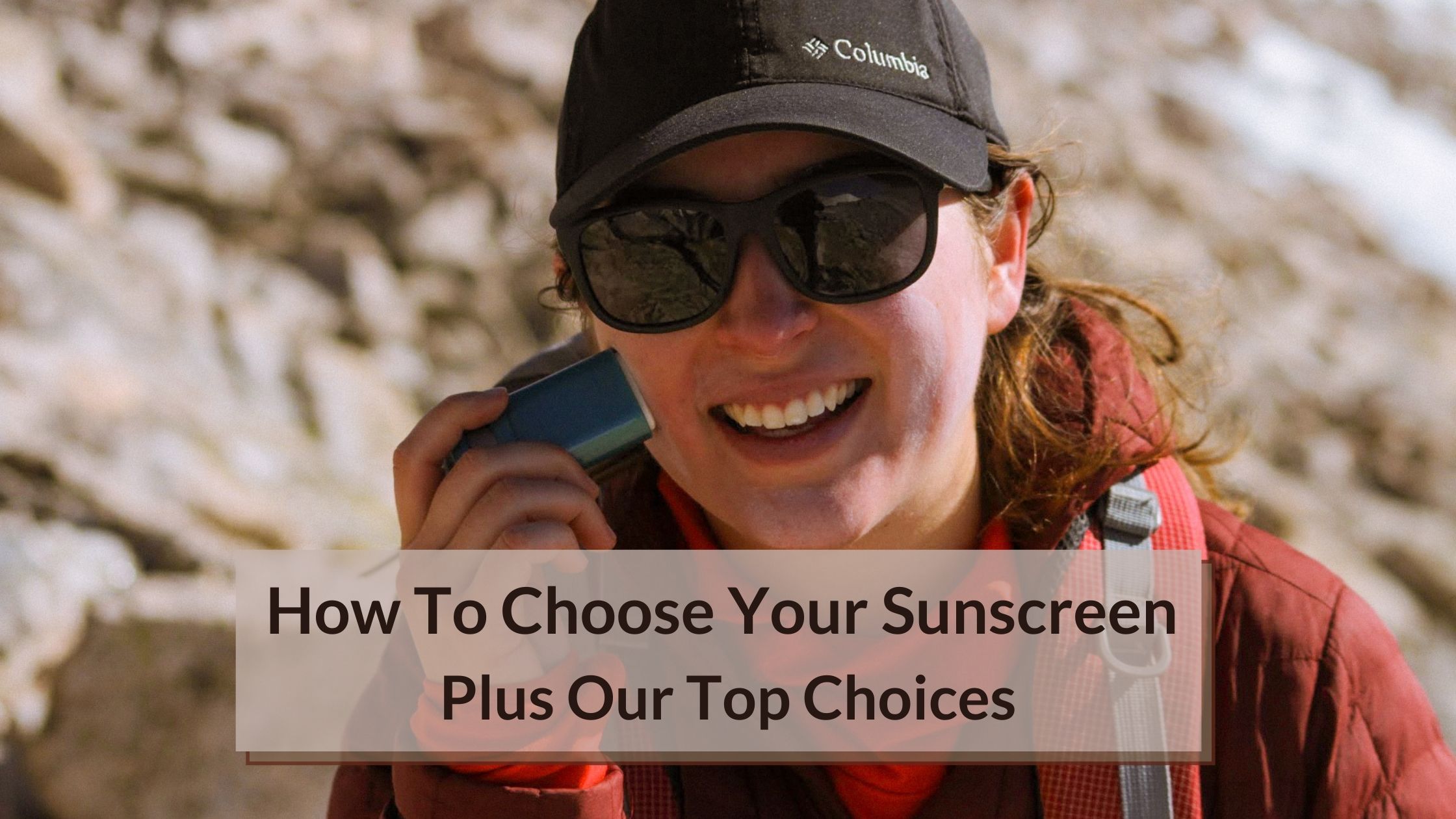This article covers how to choose the best sunscreen for you, how to apply sunscreen properly and our picks of the best sunscreens that have passed the test of long-term hiking at altitude and even swimming. We cover the most important information regarding sunscreen so you can be more educated and prepared in the outdoors.
Quick Links:
- How to Choose The Best Sunscreen
- About Broad Spectrum
- Sunscreen Filters
- Other Ingredients
- How To Apply Sunscreen Properly
- Videos
- The Best Sunscreens
The Importance Of Sunscreen
Many of us know that skin cancer and premature aging are directly associated with sun exposure. While one piece of advice dermatologists often give is to stay out of the sun to avoid this skin damage, we know that is not a real option for most. Especially for those passionate about the outdoors. Instead, we should focus on a different solution: apply high-quality sunscreens generously and often (we’ll get into more details later). While most of us have the memories of going to the park or beach as children and being smothered in a greasy, smelly, white sunscreen, things have changed since then. Today, there are high-quality formulas that are lightweight, reef safe, and sensitive skin safe!
How to choose the best sunscreen
In the UK, 9 out of 10 cases of melanoma, which is the most severe and deadly type of skin cancer, are preventable with good sun habits. While light-skinned individuals are at higher risk for skin cancers, I want to emphasize that everybody, regardless of skin tone, should be vigilant to protect their skin from unnecessary damage and inflammation. To protect yourself and your family, one major factor to consider is the type of sunscreen you should be purchasing, because let’s be clear: not all sunscreens are formulated equally.
Let’s start with the basics: what is SPF and which is best for you?
Sun protection factor, or SPF, is actually a unit of time, measuring the length of time it would take for someone to sunburn with a sunscreen product applied vs without sunscreen. Specifically, SPF refers to the ability to block ultraviolet B (UVB) rays, not ultraviolet a (UVA) rays (we’ll get into ensuring you are protected from those UVA rays later). You can think of it as UVB for burning, UVA for aging- you don’t want exposure to either. It’s important to recognize that an SPF of 60 is not double the strength of an SPF of 30.
- SPF 15 blocks 94% of UVB rays
- SPF 30 blocks 97% of UVB rays
- SPF 45 blocks 98% of UVB rays.
While SPF ratings above 45 do block slightly more rays, the actual increase in protection is pretty negligible and never reaches 100% of UVB rays.
While the FDA recommends that consumers purchase a minimum of SPF 15, the American Academy of Dermatology recommends you stick to a rating of SPF 30 and up. That will leave you with a good level of protection without having to dish out the cash for the higher SPF levels that don’t proportionally increase sun protection.
Why Broad Spectrum is Essential
You may have noticed that SPF alone does not provide any insight as to whether the product will protect you from UVA sun rays. Again, these UVA rays can lead to premature aging and can also contribute to skin cancer development, so it’s important to protect yourself from them. It is critical to use a sunscreen that is labeled broad spectrum, because this is indicative of UVA protection similarly to the numerical SPF for UVB protection. If your sunscreen is labeled broad spectrum, the UVA protection will be similar to the UVB protection as deemed by the SPF rating.
What is PA ++++?
This rating is gaining popularity in US sunscreens and stands for Protection Grade of UVA. It is not a very common rating system in the United States yet. This rating system was developed in Japan and indicates the level of UVA protection. Specifically, the more pluses it is rated with, the better the protection. Two pluses indicate using this product will result in the skin taking twice as long to tan, whereas 5 pluses will take five times as long to tan.
Are Water Resistant Sunscreens Necessary?
Some sunscreen products have been formulated to pass a test where the product will remain effective (to some degree) on the skin for some amount of time when being exposed to water. These products are not waterproof, and no sunscreen can legally label itself as being completely waterproof. If a sunscreen is labeled as water resistant, it demonstrated the SPF protective factor functioned properly up to 40 minutes in water. Similarly, if a sunscreen is labeled as very water resistant (or with 80 minutes on the bottle), the formula can maintain its SPF functionality up to 80 minutes in water.
Water resistant sunscreens may help prevent the product from dripping into your eyes, but at the end of the day you will need to reapply every couple of hours regardless. If you plan on spending the entire day splashing in the water, doing several big river crossings, or sweating bullets, it may be useful for you to look for a water resistant formula so that you are more likely protected for those activities, at least for 40-80 minutes (depending on the label). However, some of my favorite formulas do not come in water resistant formulas, and I just make sure to reapply regularly and I have never had an issue, even when sweating like crazy or swimming!
Sunscreen Filters
At the end of the day, the product formulation will be a major factor that encourages, or completely halts people from applying sunscreen regularly. Here, we’ll discuss the two major sunscreen formulations: chemical and mineral, and some important factors to keep in mind with each.
Chemical Sunscreens
Chemical filters function by first absorbing into the skin, then absorb the light energy from the sun rays and convert that light energy into heat to be dissipated into the body. These sunscreens often blend into skin without a white cast because of the lack of mineral filters. Common chemical sunscreen filters that you will find are avobenzone, oxybenzone, octocrylene, homosalate, octisalate, and octinoxate.
Chemical Sunscreen Controversies
Chemical filters are currently controversial because of the evidence of the absorption of the compounds into the bloodstream, and the damage certain chemical filters cause to oceanic ecosystems. Common chemical filters such as avobenzone, oxybenzone, octocrylene, homosalate, octisalate, and octinoxate have demonstrated an ability to absorb into the blood stream after a single use. The health implications of these chemical filters absorbing into the blood stream are still unclear. On the other hand, Hawaii will begin to ban the sale and use of sunscreens with chemical filters oxybenzone and octinoxate on January 1st, 2021 due to their damaging impact on coral reefs. It should also be noted that while everybody’s skin is different, chemical sunscreens have a higher risk to sting the eyes and irritate sensitive skin.
Mineral Sunscreen Ingredients
The minerals within mineral sunscreens, notably zinc oxide and titanium dioxide, function by physically deflecting the sun’s rays. Zinc oxide will provide great UVA and UVB coverage, more so than titanium dioxide. However, zinc oxide is what typically gives that chalky, white cast appearance. Mineral sunscreens are often infamous for this white cast. However, as I will demonstrate in the last section of this article, there are new formulations that help the formula blend in similarly to a chemical sunscreen! Unlike chemical sunscreens, mineral sunscreens do not break down. However, they do tend to come off the skin for a number of reasons (sweating, water, wiping, etc.) and do need to be reapplied similarly.
What is Non-Nano in Mineral Sunscreens?
An increasing number of products advertise they do not use non-nano titanium dioxide and zinc oxide. Interestingly, according to the FDA and Environmental Working Group, almost all of the particles in all sunscreens can be considered nanomaterials. Therefore, it seems as though this label “non-nano” is more linked to marketing than anything else. In addition, it appears that when sunscreen particles become smaller in size, they will offer better SPF protection but worse UVA protection. Therefore, the chemists and other formulators for these products have the difficult job of ensuring the particles are not too small or too large to offer true broad-spectrum coverage. As of right now, the Environmental Working Group and the FDA have not come across any conclusive scientific evidence that nanoparticles in mineral sunscreen have a significantly higher risk of absorption than non-nano particles, nor that there is any skin damage when these particles become energized by sunlight. The FDA does warn against using spray sunscreens or loose powder sunscreens with titanium dioxide or zinc oxide due to concerns about damage to the lungs with the inhalation of these particles (nano or not). More studies are currently being done to determine the real impact of inhalation of these particles.
Other Sunscreen Ingredients of Note
Fragrance
Fragrances can be anything from synthetic fragrance to essential oils (lavender, citric, etc.). Regardless of the classified term, fragrances can trigger irritation and inflammation within the skin and it offers nothing in terms of skincare or sun protection. In fact, it’s often looked down upon by dermatologists to use a sunscreen with fragrance because this is a product you use to prevent inflammation and damage. Therefore, throwing fragrance in the product goes against the overall point of using a sunscreen.
Parabens
More and more consumers are becoming aware of the acclaimed downsides to parabens. From supposed hormonal disruption to coral reef damage, parabens have gained themselves quite the bad name. In actuality, the data behind the negative effects of parabens is still weak, hence why this ingredient is still allowed to be formulated in products (at very low concentrations, may I add). However, if this is of concern for you, there is an abundance of sunscreens at all price points formulated without parabens so you can apply without worry!
Bug Repellent
Some sunscreens will have a bug repellent within it to ward off unwanted insects. However these formulas are not recommended because you should be reapplying your sunscreen often and with copious amounts, while you should apply bug repellent infrequently and to small areas of the body.
Others
I recommend that if other ingredients are of concern, you do research from reputable sources such as the FDA and Environmental Working Group websites. There are a ton of claims made vilifying or glorifying ingredients in sunscreens without any scientific data, so make sure you do your research thoroughly!
How to Apply Sunscreen Properly
So now you how to select the best sunscreen for you and your family, but that is only half the battle! The SPF rating that we discussed earlier is only the rating if you apply enough of the product onto your skin. Typical amounts applied by consumers only provide 40% of the SPF rating on the bottle. Some essential tips to make sure you are getting the protection you need are:
- Apply chemical sunscreens about a half hour before sun exposure, and mineral sunscreens just before (they are protective the moment of application)
- Make sure you bring enough sunscreen on your trip that you are able to apply every 2 hours.
- It is estimated that adults will need approximately an ounce, or a shot-glass amount, to cover the body adequately. For your face and neck, ½ teaspoon amount of sunscreen is recommended.
- Reapply your sunscreens (water resistant or not) every 2 hours even on days that are cloudy
- If you must use a spray sunscreen, though it is not recommended, make sure to truly take the time to rub it in and cover every inch
Listen, I get that it’s tempting to not slather on sunscreen on days that you plan to be out on a cloudy day. Unfortunately, nearly 80% of dangerous UV rays get through clouds on those overcast days. Therefore, you’ll still need to protect yourself.
Another important factor to remember is to check your expiration date on your sunscreen! You don’t want to follow these steps just to be a master at applying the world’s best expired sunscreen. It is also recommended to toss it 3 years after purchase (though let’s be real, I know you’ll be outside enough to be able to get through a sunscreen product in that 3 year period).
Summary: How to Choose the Best Sunscreen and Application Tips
- Coverage with clothing and a hat is optimal, but sunscreen offers great protection for areas in which this is not an option
- Purchase a broad spectrum sunscreen with an SPF of 30 or higher without chemical filters oxybenzone and octinoxate
- Mineral sunscreen will be safer for sensitive skin and to prevent stinging of the eyes
- If possible, opt for a sunscreen that is fragrance free
- Reapply an ounce or so of sunscreen on the body, and about a ½ teaspoon on the face every 2 hours
If you prefer listening to this information as opposed to reading it, here are two videos by a board-certified dermatologist with a Ph.D. in Biochemistry that explains all of the previous information in an easy-to-follow manner:
Our Favorite Sunscreen Products
I have complied some of my favorite sunscreen products that have proven themselves on Colorado 14ers and fishing trips. All of the following sunscreens will be broad-spectrum. I’ve broken them down by product type down below:
Body Sunscreen
Goddess Garden Mineral Sunscreen Sport

This is a great sunscreen at a great price point that works wonderfully as a full body sunscreen. It is formulated with 20% zinc oxide as its sunscreen component. In addition, the first inactive ingredient is Aloe Leaf Juice which is a wonderful and calming ingredient for the skin. While there is a white cast with this sunscreen, it can be worked into the body and can appear very minimal. Those with darker skin tones may want to opt for a combination or a different type of body sunscreen because this may leave a white cast on them. Overall, this sunscreen has lasted me walking through rivers and through long, sweaty days of hiking. It reapplies well and does not pill.
SPF: 50 | Non-Nano Mineral | Cruelty Free | Fragrance Free | Paraben Free | Vegan | Water Resistant (80 min) | $14-18
Non-Tinted Sunscreen
Blue Lizard Active Mineral-Based Sunscreen

This sunscreen was a good compromise if someone wants to use both a chemical and a mineral sunscreen. Because it is a combination sunscreen, the white cast is less noticeable than a mineral only sunscreen. This sunscreen layers very well for reapplying and does not pill. The active ingredients are 8.7% zinc oxide and 4% octocrylene. If you have sensitive skin, I recommend you skip this sunscreen as it has eye-burn potential. For 2 of the 3 people that tested this sunscreen, it had no issue and stayed on great, however, I experienced some eye burning. If you usually use chemical sunscreens without issue, this would be a great choice.
SPF: 30 | Combination Mineral + Chemical | Cruelty-Free | Paraben Free | Fragrance Free | Water and Sweat Resistant (80 min) | Oxybenzone and Octinoxate free | $12-20
Blue Lizard Sensitive Face Mineral Sunscreen, 3 fl oz.

This is my favorite non-tinted sunscreen, especially for those with sensitive skin. Plus, despite the lack of water/sweat resistance claim, it lasts great for long hikes and re-layers great without pilling. In fact, after a nasty face wind and sunburn, this was my go-to sunscreen for trustworthy protection without any burning sensation. The active ingredients are 1.0% titanium dioxide and 7.8% zinc dioxide. At the start of application there is a visible white cast with this sunscreen but it can be rubbed in to get rid of it almost entirely. Notable ingredients in this formula are green tea, which has high amounts of antioxidant compounds and may be soothing for irritated skin, as well as hyaluronic acid which functions as a humectant for the skin.
SPF: 30 | Mineral | Paraben Free | Fragrance Free | $13-15
Stick Sunscreen
Colorescience Sunforgettable Total Protection Sport Stick SPF 50, 0.63 oz.

This was my first stick sunscreen and it convinced me I forever need this product in my hiking bag. It takes a few swipes across your face and a few seconds to rub in and the extremely faint white cast is gone. This product has the least white cast of any of these sunscreens. You can see how faint the white cast is even on the initial application in the article cover photo where I had applied this product across my face but had not rubbed it in at all at this point. This easy application is extremely useful at the top of a mountain when you are exhausted and do not want to think about reapplying your sunscreen. The active ingredient in this sunscreen is 13.5% zinc oxide. Truly, the only downside to this product is the high price point. At $29/ounce it does not come cheap, but the quality speaks for itself. If this product is within your price range, I believe it is worth it. Just to note, this sunscreen has a unique and very light scent of cinnamon that dissipates almost immediately after application – just thought I’d point that out in case you are absolutely repulsed by that scent.
SPF 50 PA ++++ | Non-Nano Mineral | Cruelty Free | Fragrance Free | Paraben Free | Cruelty-Free | Water and Sweat Resistant (80 min) | $29
Buy On Amazon | Buy on Colorscience
Tinted Sunscreen
CeraVe Hydrating Sunscreen Broad Spectrum Sheer Tint, 1.7 fl oz

This sunscreen was a surprisingly big hit for me. While it does not advertise the ability to be water-resistant, it does a fantastic job of staying on for a long multi-hour hike. It also layers up extremely easily and had no pilling. The active ingredients are 5.5% titanium dioxide and 10% zinc oxide. The tint to this is more yellow-toned than many other sunscreens, making it perfect for those with light to dark skin tones. It is possible that with very light skin tones this tint may be slightly too dark. There are three additional ingredients to note in this product, ceramides (to support the skin barrier), niacinamide (reduces redness, oiliness, and improves overall skin appearance), and hyaluronic acid. However, it is unclear how effective these ingredients are at penetrating the skin in a sunscreen formula.
SPF 30 | Mineral | Cruelty Free | Fragrance Free | Paraben Free | Cruelty-Free | Water and Sweat Resistant (80 min) | $14-16
References
https://www.mayoclinic.org/diseases-conditions/skin-cancer/symptoms-causes/syc-20377605
https://www.cancer.org/cancer/melanoma-skin-cancer/about/key-statistics.html
https://www.webmd.com/beauty/features/high-spf-sunscreens-are-they-better
https://www.aad.org/public/everyday-care/sun-protection/sunscreen-patients/sunscreen-faqs
https://www.fda.gov/news-events/fda-voices/shedding-more-light-sunscreen-absorption
Disclaimer
This article was produced to help users understand the importance of sunscreen, what factors to consider when choosing, to educate users on sunscreen, and utilize high quality scientific research to back claims made in this article. Every sunscreen on this list was tested by our team, and recommended based on performance and ingredients. This website does get affiliate commission if an item is purchased through our links. This in no way affects our recommendations as our goal is to provide the highest quality and most helpful content possible.

Victoria Bandera has a Master’s degree in Health and Exercise Science from Colorado State University and is an ACSM certified Exercise Physiologist. Currently, Vicky is at the University of Utah working on her PhD in Population Health Sciences and working in the Huntsman Cancer Institute. She is passionate about the use of physical activity and nutrition as a source of longevity and overall health. Find her on some adventures with small health-related posts at @viqeeinthewoods on Instagram!

